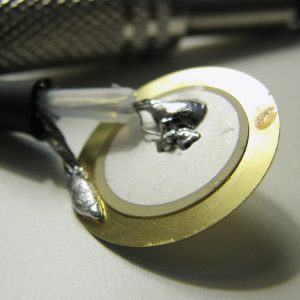In September 2008, a new night club in Rotterdam opened their doors. Their novelty to attract customers was a sustainable, energy-generating dance floor.
Unlike normal floors, an energy-generating dance floor collects the energy generated by the dancers’ jumps and turns, and transforms it into electricity. This electricity can then be used for other purposes, such as lighting, amplification and all other things that make a dance club what it is.
The physics behind this is called piezoelectricity. In short, piezoelectricity is mechanical energy transformed into electricity by means of squeezing. Some materials, usually specific classes of crystals or ceramics, have piezoelectric properties. When they are deformed – for example, by night-clubbers performing their dance moves on it – they create electrical potential. This charge can then be harvested and stored in a rechargeable battery.
This phenomenon is not new. It was discovered in 1880 by the Curie brothers, and is already widely used in gas lighters, inkjet printers, ultrasound equipment, quartz watches and not to forget, perhaps the most expressive example: the tiny little crystal on the bottom of a record player’s cartridge.
For example, when many of these crystals are put into a dance floor, they can produce sufficient electricity to power up the DJ’s equipment, provided, of course, that the music is good and enough people are willing to dance.
The club owner must certainly have seen the effect in his energy bill, although back in 2008, this technology was very expensive and the cost of the floor far exceeded its yield. However, the floor certainly attracted a lot of media attention and subsequent visitors.
However, piezoelectric technology has evolved dramatically since then and is now much more cost efficient.
 Nowadays, there are energy-generating sidewalks, subway stairs and platforms, highways, fitness centres, playgrounds and even buildings. These places aren’t chosen randomly, of course. The beauty of piezoelectric harvesting lies in the fact that it collects energy that has already been wasted. Let people drive, walk, play, run and dance as they always do, and turn the energy produced by these everyday activities into a renewable product.
Nowadays, there are energy-generating sidewalks, subway stairs and platforms, highways, fitness centres, playgrounds and even buildings. These places aren’t chosen randomly, of course. The beauty of piezoelectric harvesting lies in the fact that it collects energy that has already been wasted. Let people drive, walk, play, run and dance as they always do, and turn the energy produced by these everyday activities into a renewable product.
The amount of energy produced by a single piezoelectical cell is small, so large scale energy harvesting in places with high density traffic seems to be the most cost efficient application of the principle. However, this certainly isn’t the end of it; increasingly more technology no longer requires a lot of power any longer, such as sensors and LED lights. Sensors fed by batteries produce waste when the battery is replaced. A self-sustaining piezoelectical sensor does not.
Less power-hungry technology combined with the idea of “just keep on doing what you’re doing” opens up new horizons for small scale piezoelectric applications. In the medical field for example, cardiac pacemakers can be powered by energy harvested from the carrier’s own pulsating arteries, essentially turning a person into their own power source.
So, what if all of us could turn ourselves into a power source? This is no longer science fiction either.
Traditionally, military applications are a huge driver for academic research into new technologies, and this had led to piezoelectric textiles that collect energy from a soldier’s movements, storing it in wearable batteries. This application immediately reduces the number of batteries soldiers have to carry with them in order to power their electronic devices, giving the soldier an advantage over those who travel a lot less lightly and reducing the risk of running out of power at critical moments.
As it happens, these new technologies are currently too costly for the consumer market, although cars and computers were once too. Given the current commercial interest in this technology, it is only a matter of time before the market finds ways of making wearable energy harvesting and storage more cost effective, the batteries more flexible and the fabrics more attractive.
When this happens, wearable, stretchable batteries integrated in energy-harvesting textiles or the soles of our shoes can replace the classic battery by producing and storing energy through simply living our daily lives, allowing us to recharge our mobile electronics as we go. A cell phone running out of power will then be a definitive thing of the past, and just imagine all the other things we can do with this reclaimed energy.
Want more?
Want more? Don’t be sad that the article is over! We got plenty of other exciting stuff to share with you. Subscribe to our monthly newsletter and we’ll keep you up to date with our latest news!


Leave a reply